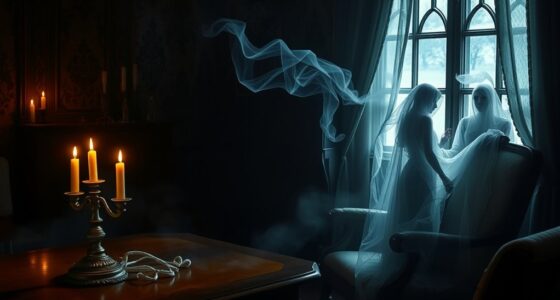Ghosts wear clothes because these garments reflect cultural beliefs about the afterlife, morality, and spiritual progression. Funeral attire symbolizes respect, purity, and societal status, emphasizing the importance of sacred traditions. Their clothing shows how different cultures interpret spirits’ roles, moral judgments, or unresolved issues. Over time, ghost fashion has evolved from simple shrouds to elaborate outfits, revealing fears, hopes, and collective values. Exploring these themes further uncovers how clothing shapes our understanding of life, death, and what lies beyond.
Key Takeaways
- Ghosts wear clothes to symbolize their social status, moral judgment, or unresolved issues from their past lives.
- Funeral attire in the afterlife reflects cultural beliefs about spiritual transition and the soul’s journey.
- Clothing in ghost depictions conveys societal values, norms, and collective perceptions of morality and mortality.
- Ghostly garments serve as visual cues of authority, purity, or chaos, enhancing storytelling and spiritual symbolism.
- Traditional funeral fashions and ghost attire reveal cultural attitudes toward death, the afterlife, and moral judgment.
The Historical Roots of Mourning Attire in Spirit Depictions
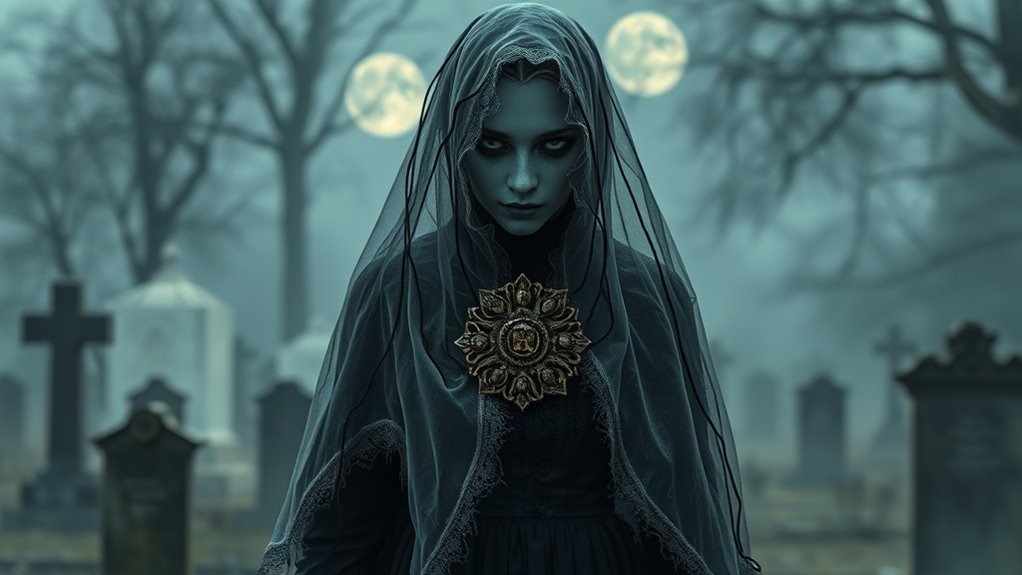
The depiction of spirits in mourning attire has deep historical roots that reflect societal attitudes toward death and the afterlife. Funeral customs across cultures often involve specific garments that symbolize respect, loss, and spiritual transition. These clothes serve as visual cues, emphasizing the solemnity of death and the importance of honoring the departed. Spiritual symbolism embedded in funeral attire highlights beliefs about the soul’s journey, purity, or separation from the living world. Over time, these customs influenced how spirits are portrayed in art and stories, often dressed in traditional mourning clothes to signify their status and emotional state. By understanding these historical roots, you see how clothing in the afterlife acts as a bridge between cultural rituals and spiritual symbolism, shaping perceptions of death itself. Additionally, funeral clothing has historically served to communicate social status and community values, reinforcing the significance of proper attire in both life and death. The choice of clothing for spirits often reflected regional cultural practices, further emphasizing the importance of attire as a form of spiritual expression. Recognizing the foraging behaviors of different cultures can also reveal how specific garments or adornments were chosen based on available materials and local traditions. Moreover, the evolution of funeral fashion over centuries demonstrates how societal changes influence spiritual representations.
Cultural Significance of Clothing in the Afterlife
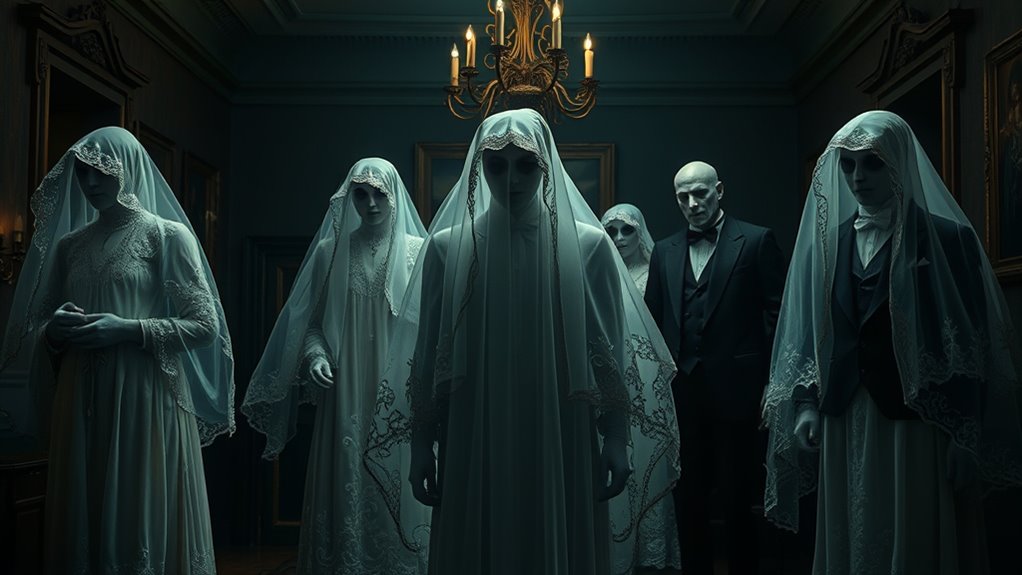
Clothing in the afterlife holds profound cultural significance because it reflects beliefs about identity, status, and spiritual passage. During funeral rituals, specific garments symbolize respect, purity, or spiritual readiness, reinforcing social and spiritual hierarchies. These clothes often carry deep spiritual symbolism, representing the soul’s journey, protection, or connection to the divine. In many cultures, funeral attire helps distinguish the deceased’s role or status in the spiritual domain, emphasizing their transition from the earthly to the afterlife. Wearing particular garments during rituals also serves as a visual reminder of cultural values and beliefs about life after death. Additionally, funeral attire can incorporate specific colors, fabrics, or motifs that hold symbolic meaning within a community, further enhancing the spiritual message conveyed. Decorative details on funeral clothing can convey messages of hope, protection, or the continuation of familial bonds beyond death. These garments often reflect the community’s cultural identity and collective beliefs about what awaits in the afterlife, reinforcing shared values and traditions. For example, the choice of fabrics and designs often aligns with traditional ritual practices, emphasizing their importance in spiritual ceremonies. The use of clothing symbolism helps to communicate complex spiritual ideas visually, making the intangible beliefs more tangible for the living. Ultimately, clothing becomes a powerful expression of cultural identity, reinforcing the idea that the afterlife is an extension of the values and traditions held in this world.
How Clothing Reflects the Spirit World in Popular Media
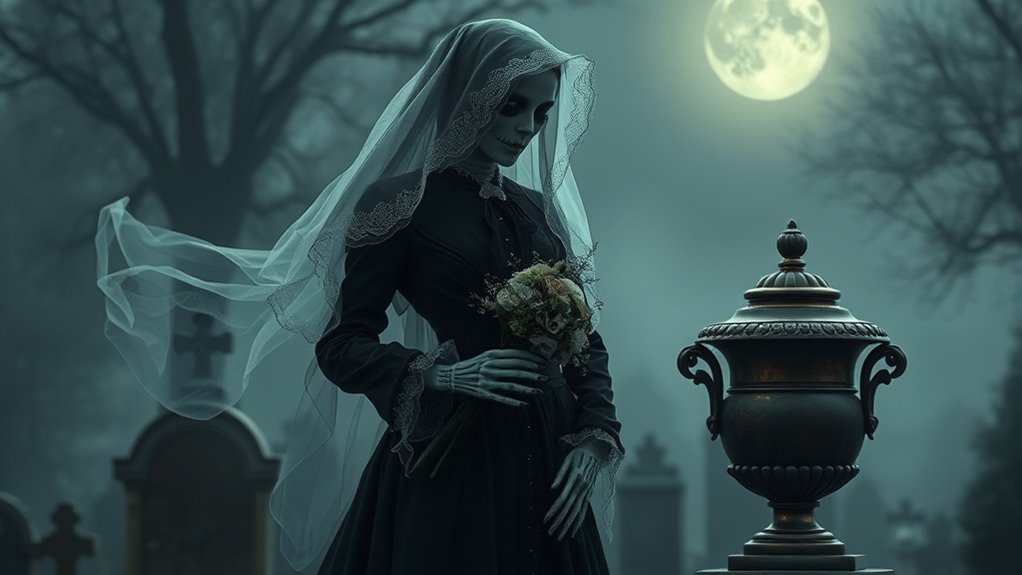
In popular media, costumes and wardrobe choices often serve as visual cues to portray the spirit world, revealing how societies interpret the supernatural domain. You’ll notice spectral uniforms that symbolize ghostly authority or societal status, emphasizing their connection to the living world. Phantom accessories, like glowing chains or ethereal jewelry, highlight their otherworldly nature. These clothing elements often reflect cultural beliefs about the afterlife, making spirits more recognizable and relatable. Sometimes, ghosts wear tattered remnants of their earthly clothes to evoke tragedy or unfinished business. Other times, they’re dressed in pristine, formal attire, signifying purity or divine origin. These visual cues help you understand a spirit’s role, origin, or emotional state, making the supernatural more tangible through clothing choices. Additionally, the clothing styles assigned to spirits often mirror specific cultural and historical contexts, providing insight into societal attitudes toward the afterlife and the supernatural. The use of costume symbolism enhances storytelling by conveying complex ideas about morality, status, and spiritual transformation without words. Moreover, the influence of butter’s artistic significance can be seen in the way costumes are crafted with attention to detail and symbolism, enriching the visual storytelling of the supernatural realm. Incorporating specific craftsmanship techniques in costume design also helps evoke authenticity and emotional depth in portrayals of spirits and supernatural beings. Furthermore, understanding how material choices affect costume durability and appearance can deepen the connection between the spirit’s story and its visual representation.
The Evolution of Ghostly Fashion Through Time
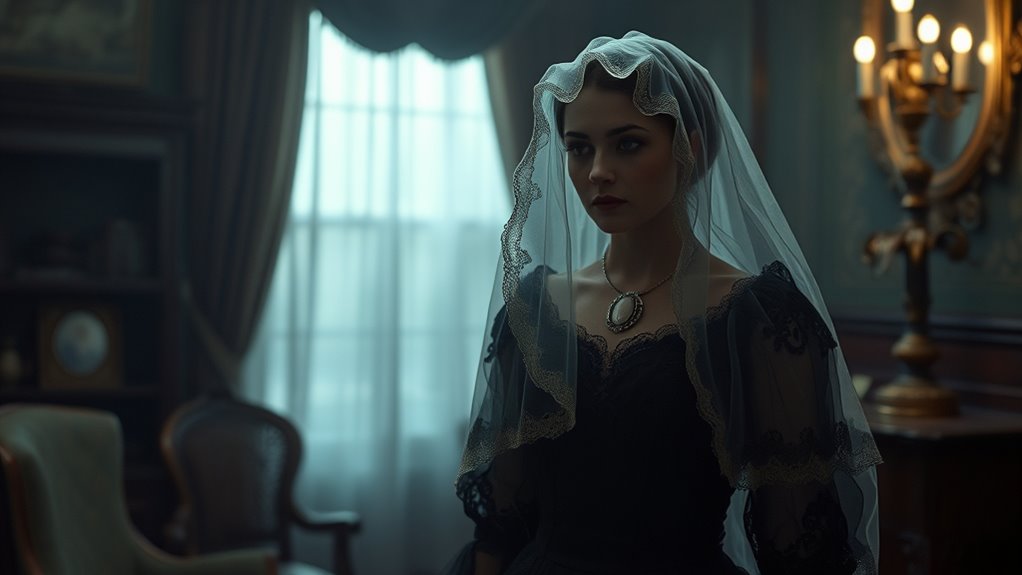
Over the centuries, ghostly fashion has transformed alongside societal ideas about death and the afterlife. In ancient times, spirits appeared draped in simple shrouds, symbolizing humility. During the Renaissance, spectral accessories like ornate jewelry and veiled figures reflected status even beyond death. Haunted fashion evolved further in the Victorian era, with ghosts donning mourning garments and top hats. This shift illustrates how cultural attitudes influenced ghostly attire. Additionally, modern ghostly fashion sometimes incorporates spectral accessories like glowing or translucent elements to evoke an ethereal presence. The influence of vetted Halloween product reviews on costume design has also contributed to more creative and diverse ghostly ensembles.
What Ghostly Garments Reveal About Human Fears and Beliefs
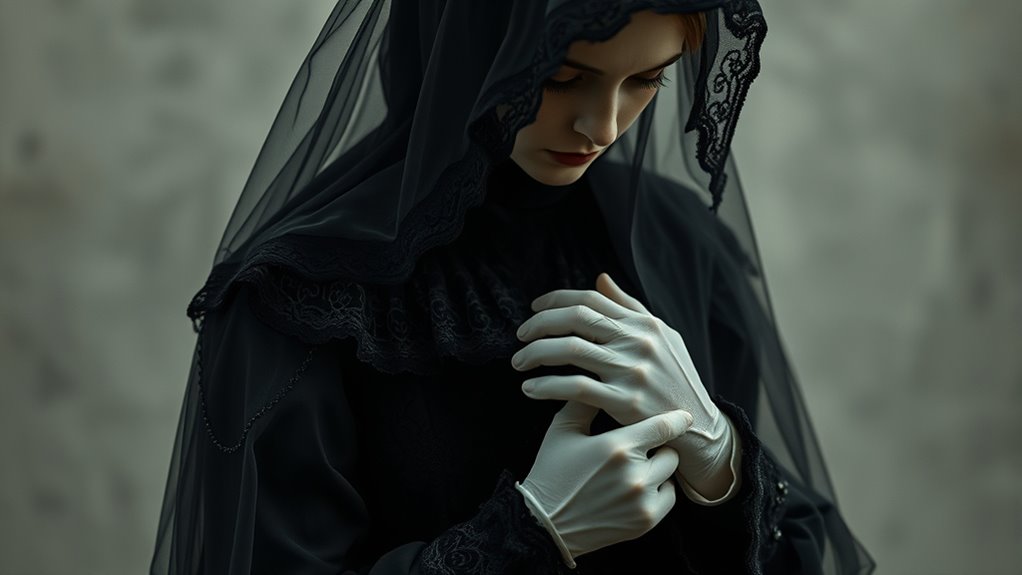
Ghostly garments serve as powerful symbols of human fears and beliefs about death, the afterlife, and what lies beyond. They reveal how cultures interpret the supernatural symbolism of clothing rituals, reflecting hopes, anxieties, and societal values. When you see ghosts dressed in particular ways, it often signifies symbolic meanings—protection, status, or unresolved issues. These garments can embody fears of chaos or the unknown, or serve as a comforting link between the living and the dead.
Ghostly garments symbolize fears, hopes, and societal values about death and the afterlife.
- Clothing rituals express cultural views on purity, respect, or transition.
- Ghostly attire may symbolize spiritual status or unresolved conflicts.
- Certain garments evoke fears of decay, loss, or the supernatural’s chaotic nature.
- The way ghosts are dressed reveals collective beliefs about the afterlife and moral judgment.
Frequently Asked Questions
Do Ghosts Choose Their Outfits or Are They Assigned Clothing?
You might wonder if ghosts choose their outfits or if they’re assigned clothing. Usually, it’s believed they have free will, selecting attire based on personal preferences or cultural norms from their lifetime. Some spirits may stick to familiar clothing, while others pick outfits that reflect their past lives or current feelings. Ultimately, it’s a blend of personal choice and cultural influences that determines what ghosts wear in the afterlife.
Are There Specific Colors or Styles That Ghosts Prefer?
You might wonder if ghosts have favorite colors or styles. Some believe spectral fashion choices reflect their personalities or emotions, with ghostly color preferences leaning toward muted, pale shades or familiar attire. Others suggest they pick clothing that holds sentimental value or symbolizes their life. While there’s no definitive answer, it’s fun to imagine that ghosts choose their outfits to express themselves, just like the living do with their wardrobe choices.
How Do Ghostly Garments Differ Across Various Mythologies?
When you picture ghostly garments, you might think they’re uniform, but spectral attire varies wildly across mythologies. In Japanese folklore, phantoms wear ethereal kimonos, shimmering with spiritual energy, while European legends depict spirits in tattered cloaks or shrouds. These phantom fashion choices reflect cultural beliefs about death, the afterlife, and spiritual purity. Each mythology’s spectral attire offers a unique glimpse into how different cultures interpret the afterlife’s ghostly inhabitants.
Can Clothing Influence a Ghost’S Ability to Interact With the Living?
You might wonder if spectral attire affects a ghost’s interaction with the living. Haunted fashion, like specific garments or accessories, could act as a conduit or barrier, influencing their ability to communicate or manifest. Clothing might hold emotional or spiritual significance, enhancing their presence or limiting it. So, yes, haunted fashion could play a role in how ghosts connect with the physical world, making their spectral attire more than just appearance.
Are There Modern Fashion Trends Seen in Ghostly Apparitions Today?
Think of ghostly apparitions as echoes of fashion evolution, where the past and present collide. Today, you might see spirits adorned with modern trends like sneakers or designer accessories, acting as ghostly accessories that reflect current styles. These apparitions seem to mirror your world, blending timeless ghostly presence with contemporary fashion. It’s as if the afterlife adopts your trends, making each encounter a fascinating glimpse into evolving ghostly fashion.
Conclusion
Ultimately, understanding why ghosts wear clothes reveals more than just fashion; it uncovers humanity’s deepest fears, hopes, and cultural echoes that resonate through eternity. Your fascination with spectral attire isn’t just curiosity—it’s a window into our collective psyche, an endless mirror reflecting the grandeur of our beliefs. As you ponder these ghostly garments, remember: their significance is as vast and profound as the universe itself, making this mystery an eternal dance of shadow and meaning.


